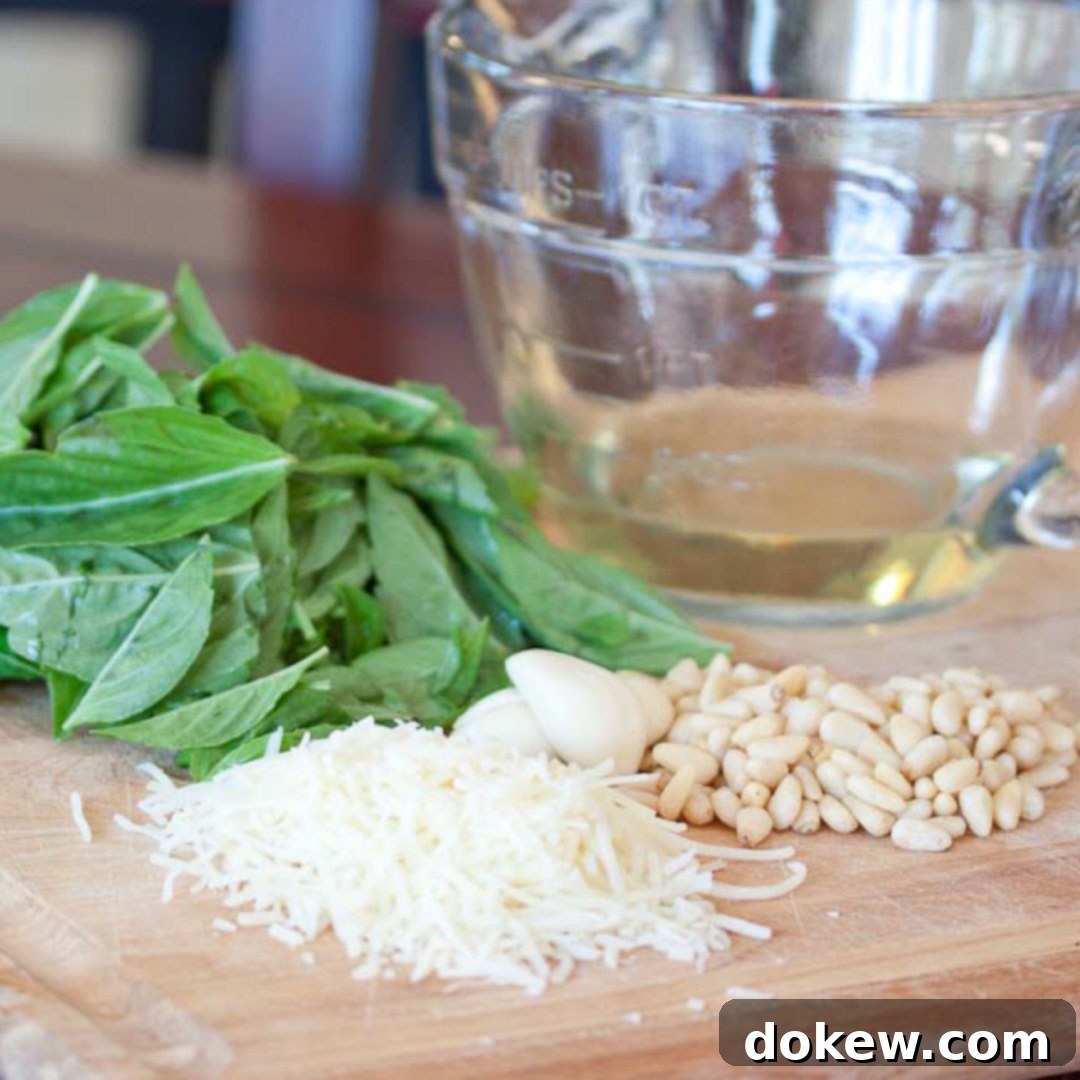Mastering Homemade Pesto: Your Ultimate Guide to Fresh, Flavorful, and Easy Basil Pesto
There’s nothing quite like the vibrant, aromatic taste of homemade pesto. This incredibly versatile sauce, bursting with the freshness of basil, the richness of olive oil, the nuttiness of pine nuts, and the sharp tang of Parmesan cheese, transforms any dish. Whether you’re tossing it with pasta for a quick weeknight meal, slathering it onto chicken or fish, or using it as a gourmet spread for sandwiches and bruschetta, fresh pesto elevates your culinary creations with minimal effort. Forget expensive store-bought versions that often lack the true zest; making pesto at home is surprisingly simple, deeply satisfying, and remarkably cost-effective.
One of the secrets to truly exceptional pesto lies in fresh basil. Many might assume a constant supply of fresh basil is costly or difficult, but it doesn’t have to be. You can easily keep living basil plants on hand year-round if you have a sunny window. Most grocery stores offer potted basil plants for under five dollars. With a little care—consistent watering and a bright, sunny spot—these plants will flourish for months, providing a continuous harvest of aromatic leaves ready for your next batch of pesto. This small investment quickly pays for itself when compared to the price of purchasing pre-cut fresh basil, making homemade pesto an economical and flavorful choice for any kitchen.
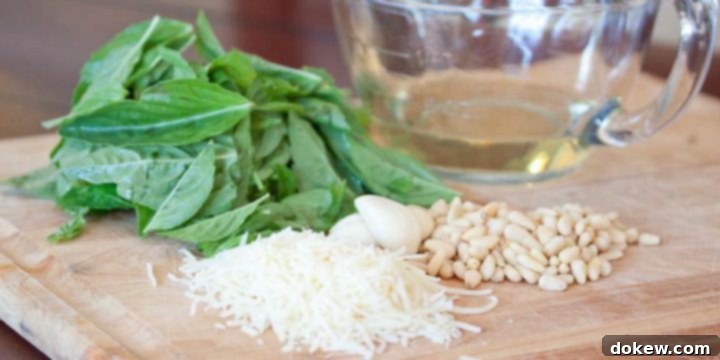
Even if you need to replace your basil plants once or twice a year, particularly during the shorter, darker days of mid-winter, the expense remains minimal. This approach ensures you always have the freshest, most fragrant basil at your fingertips, which is absolutely crucial for an authentic and flavorful pesto. Think of it as a small, living herb garden right in your kitchen! Beyond its culinary uses, growing basil is a rewarding experience. For more in-depth information about basil and its many benefits, explore resources like the Basil Fact Sheet.
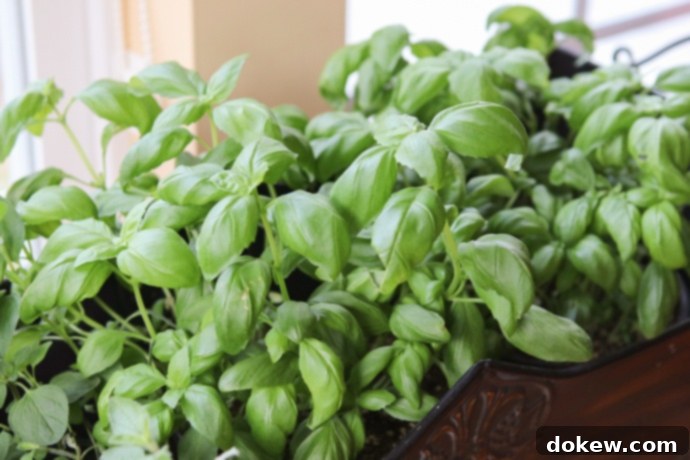
Why Homemade Pesto is Always the Best Choice
Making pesto from scratch offers numerous advantages over store-bought alternatives. The most significant difference is, of course, the taste. Freshly made pesto possesses an unparalleled brightness and depth of flavor that pre-packaged versions simply cannot replicate. The vibrant aroma of just-picked basil combined with freshly grated Parmesan and toasted pine nuts creates a sensory experience that transforms even the simplest meal into something special.
Beyond flavor, homemade pesto gives you complete control over the ingredients. This is especially beneficial if you have dietary restrictions, allergies, or simply prefer to know exactly what goes into your food. You can choose high-quality extra virgin olive oil, adjust the amount of garlic to your liking, and even experiment with different types of nuts or cheeses. This customization is a luxury that industrial pesto products rarely offer.
The Heart of Pesto: Fresh Basil
As the name suggests (“pesto” comes from the Italian verb “pestare,” meaning to crush or pound), basil is the foundational ingredient for this beloved Italian sauce. The quality and freshness of your basil will directly impact the final flavor of your pesto. For this recipe, we call for 2 cups of fresh basil leaves. If you’re not growing your own, a single potted basil plant from the produce section of most grocery stores should yield enough leaves for a batch. Look for plants with vibrant green leaves, no wilting, and a strong, sweet aroma.
Growing Your Own Basil for a Continuous Supply
Cultivating your own basil is an incredibly rewarding endeavor and the most cost-effective way to ensure a steady supply for fresh pesto. When you purchase a potted basil plant from the grocery store, gently transfer it to a slightly larger pot with good drainage and quality potting soil. Place it in a sunny location, ideally a south-facing window, where it can receive at least 6 hours of direct sunlight per day. Basil loves warmth and sunlight! Water your basil plant regularly, ensuring the soil remains consistently moist but not waterlogged. Allow the top inch of soil to dry out slightly between waterings.
To encourage bushy growth and prevent your plant from “bolting” (flowering and producing seeds, which can make the leaves bitter), pinch off the top sets of leaves regularly. This encourages the plant to grow outwards rather than upwards, yielding more leaves for your pesto. With proper care, your living basil plant can thrive for many months, providing fresh, aromatic leaves whenever you need them. This sustainable approach not only saves money but also ensures maximum flavor in every batch of homemade pesto.
Essential Pesto Ingredients: Beyond Basil
While basil is the star, the supporting cast of ingredients in pesto plays an equally crucial role in creating its iconic flavor profile.
Pine Nuts (and Flavorful Alternatives)
Pine nuts contribute a delicate, buttery texture and a subtle, earthy flavor to pesto. For an even more enhanced taste, gently toast the pine nuts in a dry pan over medium heat for 2-3 minutes until lightly golden and fragrant. Be careful not to burn them, as they can go from perfectly toasted to scorched very quickly! If pine nuts are expensive or hard to find, or if you simply want to experiment, excellent alternatives include:
- Walnuts: Offer a slightly more robust, earthy flavor.
- Almonds: Provide a milder, sweeter nuttiness.
- Cashews: Create a creamier texture and a delicate flavor.
- Sunflower Seeds: A great nut-free option, offering a subtle crunch and a mild, toasty taste.
Parmesan Cheese
Always opt for freshly grated Parmesan cheese (Parmigiano-Reggiano) for the best results. Pre-grated cheeses often contain anti-caking agents that can affect the texture and flavor of your pesto. The sharp, salty, and umami notes of Parmesan are essential to balancing the basil and olive oil. If you prefer, a blend of Parmesan and Pecorino Romano (a sharper, saltier sheep’s milk cheese) can add another layer of complexity.
Garlic
Fresh garlic cloves are indispensable for pesto. Their pungent, aromatic kick is a key component. This recipe calls for 3 large garlic cloves, minced, but you can adjust this amount to your personal preference. For a milder garlic flavor, you can lightly blanch the garlic cloves in boiling water for a minute or two before adding them to the food processor, or even use roasted garlic for a sweeter, less intense profile.
Olive Oil
A good quality extra virgin olive oil is paramount. It binds all the ingredients together, providing a silky texture and contributing its own fruity, sometimes peppery, notes. Avoid using a strong, bitter olive oil that might overpower the delicate basil flavor. A medium-bodied, smooth extra virgin olive oil is usually the best choice. Remember to add it slowly to achieve the desired emulsion and consistency.
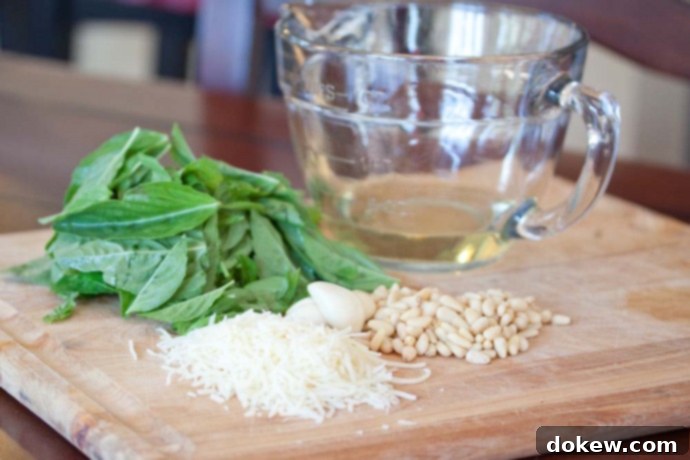
One of the beauties of this homemade pesto recipe is its speed. If you’re serving pesto with pasta, the pesto can be prepared in the exact amount of time it takes for your pasta to boil. This makes it a perfect, quick stovetop meal for busy weeknights, delivering gourmet flavor without the fuss.
Recipe
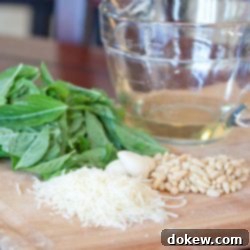
Homemade Pesto
Mary Ann
Go to Collections
Add to Shopping List
Go to Shopping List
10 minutes
10 minutes
Sauce
Gluten-free, Italian, Vegetarian
1
recipe
1278
Ingredients
-
2
cups
fresh basil leaves,
washed, stems removed, and gently packed into the measuring cup -
¼
cup
Parmesan Cheese, freshly grated -
½
cup
extra virgin olive oil, high quality recommended -
3
tablespoon
pine nuts, lightly toasted (optional) -
3
large garlic cloves, minced - Salt and freshly ground black pepper, to taste
Prevent your screen from going dark
Instructions
-
Begin by placing the fresh basil leaves into a food processor. Work in small batches to ensure even chopping. Process until the basil is finely chopped.
-
Next, add approximately one-third of the pine nuts and minced garlic to the food processor. Blend again until these ingredients are well incorporated with the basil.
-
Now, add about one-third of the Parmesan cheese. With the food processor running on a slow speed, gradually drizzle in one-third of the olive oil. This slow addition helps emulsify the pesto, creating a smooth, creamy texture.
-
Stop the food processor occasionally to scrape down the contents from the sides of the container towards the bottom. Continue processing until a smooth, thick paste is formed. The consistency should be spreadable yet retain some texture from the basil and nuts.
-
Repeat the process (steps 2 and 3) two more times, adding the remaining nuts, garlic, cheese, and olive oil in roughly equal portions, until all ingredients are used and thoroughly blended. Taste and adjust seasoning with salt and freshly ground black pepper as needed.
Notes
Nutrition data is calculated for the entire recipe as prepared.
Nutrition per serving
Calories:
1278
cal
Carbohydrates:
9
g
Protein:
15
g
Fat:
135
g
Sodium:
407
mg
Fiber:
2
g
Sugar:
2
g
Share
Pin
Serving & Storage Tips for Your Homemade Pesto
Once your fresh, vibrant pesto is ready, the culinary possibilities are endless! While it’s famously paired with pasta (especially spaghetti, fettuccine, or linguine), don’t limit its potential. Here are some ideas:
- Pasta Sauce: Toss it generously with your favorite hot pasta for a simple yet satisfying meal. Add a splash of pasta water to thin it out if needed.
- Protein Power-Up: Spread it over grilled chicken, baked fish (like salmon or cod), or even scrambled eggs for a burst of flavor.
- Sandwich & Wrap Spread: Ditch the mayonnaise and elevate your sandwiches, paninis, and wraps with a layer of pesto.
- Pizza Base: Use it as a vibrant alternative to traditional tomato sauce on homemade pizzas.
- Vegetable Dip: Mix it with Greek yogurt or sour cream for a creamy, herbaceous dip for raw vegetables.
- Salad Dressing: Whisk a spoonful with extra olive oil and a squeeze of lemon juice for a quick, flavorful salad dressing.
- Bruschetta & Crostini: Spread it on toasted bread, top with fresh tomatoes or mozzarella, and enjoy a delightful appetizer.
Freezing Pesto for Future Enjoyment
As mentioned in the recipe notes, homemade pesto freezes beautifully, allowing you to enjoy the taste of summer basil all year long. To best preserve its color and flavor:
- Ice Cube Trays: Spoon the pesto into ice cube trays. This creates convenient, single-serving portions.
- Olive Oil Layer: After filling the trays, pour a thin layer of olive oil over the top of each pesto cube. This acts as a barrier, preventing air exposure and minimizing discoloration.
- Freeze Solid: Freeze until the cubes are solid, typically a few hours.
- Transfer & Store: Once frozen, pop the pesto cubes out of the trays and transfer them to a freezer-safe, airtight bag or container. Label with the date. Frozen pesto can last for 6-9 months.
- Thawing: Simply take out the desired number of cubes and let them thaw in the refrigerator or at room temperature, or add them directly to warm pasta or soup.
For refrigeration, store fresh pesto in an airtight container in the fridge for up to a week. Again, pouring a thin layer of olive oil over the surface helps maintain its fresh green color.
Explore Pesto Variations for Endless Flavor
While classic basil pesto is a culinary masterpiece, the basic formula is incredibly adaptable. Don’t hesitate to experiment with different ingredients to create your own signature pesto:
- Herb Variations: Try using other fresh herbs like cilantro, parsley, mint, or even arugula for a peppery kick. You can use them on their own or combine them with basil.
- Nut Swaps: As mentioned, walnuts, almonds, cashews, or even sunflower seeds can replace pine nuts, each offering a unique flavor and texture.
- Cheese Choices: While Parmesan is traditional, experiment with Pecorino Romano for a sharper taste, or a blend of both.
- Citrus Brightness: A squeeze of fresh lemon juice or a pinch of lemon zest can add a wonderful brightness and help prevent browning.
- Sun-Dried Tomato Pesto: Blend sun-dried tomatoes (oil-packed, drained) with basil, garlic, nuts, and cheese for a rich, savory red pesto.
Homemade pesto is more than just a sauce; it’s a celebration of fresh ingredients and simple flavors. By following this guide, you’ll be well on your way to creating delicious, vibrant pesto that will impress your family and friends, and elevate your everyday meals. Enjoy the process of crafting this Italian classic, and savor every aromatic bite!
More delicious recipes with vegetarian options:
- Lemon Orzo with Asparagus, Parmesan, and Peas
- Crustless Cottage Cheese Quiche
- Carrot Sweet Potato Soup with Ginger – Perfect for Any Season
- Roasted Garlic Broccoli
